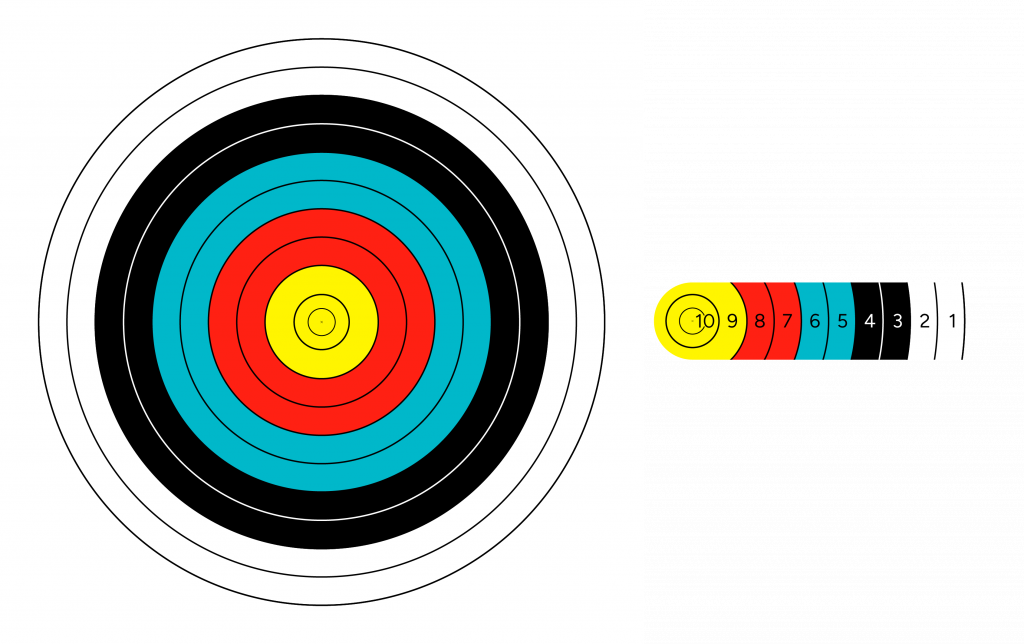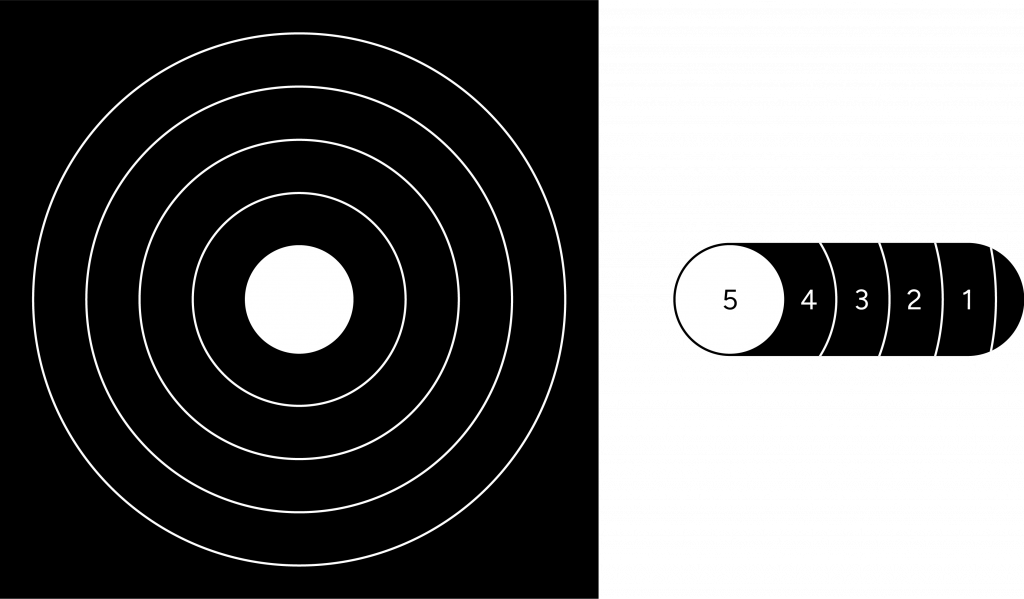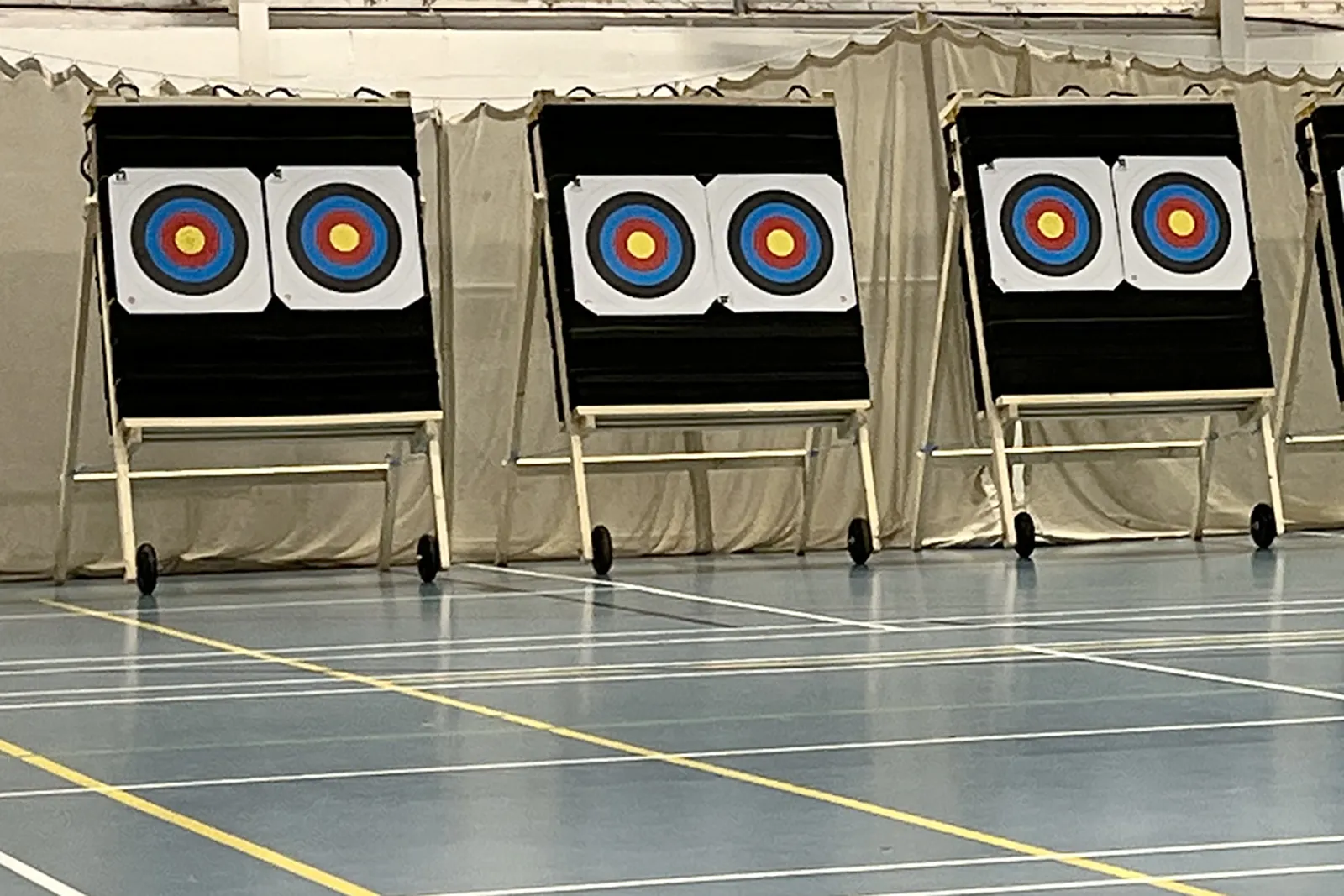During the winter season, for evening shoots we retreat to the warmth and light indoors. There are several indoor rounds that we shoot that all have different scoring systems, distances and the number of arrows shot. Below is an introduction to some of the indoor rounds we shoot over winter.
The Portsmouth
The Portsmouth round (or simply the Portsmouth) is the staple round of indoor shooting in the winter season.
The round is shot over 20 yards on a 60cm target face with a ten-zone scoring system. It begins with six sighters – non-scoring arrows shot so that archers can fine-tune their aim and sights – shot over two ends of 3 arrows. The round itself then consists of shooting 5 dozen (60) arrows over 20 ends of 3 arrows.
The Portsmouth is slightly unusual in its scoring, in that while it is an imperial round with distance measured in yards, it uses metric ten-zone scoring.

We operate a scoring badge award scheme for the Portsmouth. These badges are awarded for achieving a specified benchmark score or above. The benchmarks are 300, 325, 350, 375, 400, 425, 450, 475, 500, 525, 550, 575 and 580. Scoring your round and achieving the next badge can be a great way for beginners to measure and show their progress. While some clubs award badges for the highest score at the end of the season, we award badges as soon as the score is achieved and verified.
CWAA also run a Winter Postal Portsmouth Competition during the indoor season, with scores submitted by the club competitions officer.
For formal competitive shooting, each target boss will have two target faces, with 2 archers assigned to each face – so 4 archers top each boss. See our guide to competitive shooting for more information on how this works. In competitions, the Portsmouth can be shot either timed or untimed.
The Worcester
The Worcester Round is unusual in that it is shot on a special black-and-white face, which is only used for this round. The target face is 40cm with a 1-5 zone scoring system. The round is shot at 20 yards. One end of 5 arrows is shot for sighters, then the round proper is 5 dozen (60) arrows shot over 12 ends of 50 arrows.

The Bray I
The Bray I is a shorter round at only 2 and a half dozen (30) arrows. The target face used I the traditional coloured face, but smaller than the face used in the Portsmouth at only 40cm. As with the Portsmouth, the round is shot at 20 yards, with arrows being shot in 10 ends of 3 arrows. For the Bray I, rather than a set number of sighters, unlimited practice is allowed before scoring proper. In competition settings, this is generally set at 45 minutes rather than being unlimited.
The WA 18M
As the name implies, this round is a metric distance of 18 metres. It uses the smaller 40cm 10 zone target face and is shot in ends of 3 arrows to a total of 60 arrows over 20 ends. As with the Bray I, unlimited practice is allowed before scoring.
Scoring
Your score at the end of the round is the combined score for each arrow over the round. It is also important to record the number of ‘hits’ (scoring arrows) and ‘golds’. A ‘gold’ is an arrow that is in the highest numerical scoring zone. This can be a little confusing, as there are two gold areas on coloured faces and none on the Worcester! The WA 18 is scored differently in that the number of 9s and 10s scored is recorded, rather than hits and golds.
Scoring can be done on paper score sheets or using a scoring app. For club shoots you note your own scores, but in competitions writing the scores down is usually the job of a defined ‘scorer’. You should write down or indicate your scores from highest to lowest. When you have 6 arrows in total (5 for the Worcester round) – you then add up the scores for the ‘end’. Then after you have shot 12 arrows (10 for the Worcester), add the score for both ends and then add this to your running total. You should also record the number of hits and golds or 10s and 9s for the WA18. This is important, as archers are ranked based on score, the number of hits, then the number of golds etc. so where scores and hits are equal, golds can make the difference.
Where an arrow is on a line between two scores – known as a ‘line cutter’ – the highest score should be recorded. If you are unsure if the arrow is indeed a line cutter and so unsure as to which score applies, then call a judge who will make the call. During club shoots, the line captain acts as the judge in this case.
At the end of shooting your score should be witnessed by a fellow club archer. This will usually be the archer who you are sharing a target with. You can then submit your score to the records officer, who will use your submitted scores to calculate your handicap and classification.
Scoring in competitive shooting is done slightly differently from our standard club shoots, which you can find out more about on our competition information page.
See our page on scoring for more information.
Summary
The table below summarises relevant information for the rounds described.
| ROUND | DISTANCE | TARGET FACE | SIGHTERS | ARROWS PR END | TOTAL ARROWS | ALSO SCORE |
| PORTSMOUTH | 20 YARDS | 60CM | 2×3 | 3 | 60 | HITS + GOLDS |
| WORCESTER | 20 YARDS | 40CM | 1×5 | 5 | 60 | HITS + GOLDS |
| BRAY I | 20 YARDS | 40CM | UNLIMITED | 3 | 30 | HITS + GOLDS |
| WA 18 | 18 METRES | 40CM | UNLIMITED | 3 | 60 | 9S + 10S |
Additional rules
Some additional rules apply to the indoor rounds, which you will need to be aware of when shooting – especially under competition conditions.
Bouncers
A ‘bouncer’ is an arrow that hits the target face, but either immediately bounces off or falls out immediately after hitting the target face. For indoor rounds, bouncers are dealt with slightly differently depending on the round being shot.
Portsmouth and Worcester:
If an arrow bounces out of the target, you may shoot a replacement arrow with the judge’s permission. For club shoots, the line captain stands as the judge.
WA 18m and Bray 1
If an arrow bounces out of the target, then you must stop shooting and inform a judge (or the line captain at club shoots) who will mark and score the unmarked hole on the target face.

